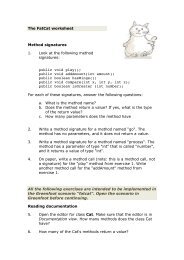SCIENCE TEST
SCIENCE TEST
SCIENCE TEST
Create successful ePaper yourself
Turn your PDF publications into a flip-book with our unique Google optimized e-Paper software.
that bubbles were still 4visible after 15 minutes. However, from Experiment 3 we also<br />
learned that there were no bubbles visible after 2 hours, and in Trial 5 of Experiment 2,<br />
we saw that after the can was set aside for 2 hours, roll time went back to the baseline<br />
speed of 1.75 seconds. 4Passage IV<br />
Figure 2 shows the average rat<br />
various wavelengths as a percent o<br />
The chemical reactions associated with photosynthesis photosynthesis at 670 nm.<br />
Passage IV Passage can be summarized IV with the following chemical equation:<br />
Figure 2 shows the average rat<br />
The chemical reactions associated with photosynthesis can be summarized with the following various chemical 110<br />
wavelengths as a percent o<br />
equation:<br />
6,CO The chemical reactions associated with photosynthesis photosynthesis at 670 nm.<br />
2 + 12,H<br />
can be summarized<br />
2O + energy → C<br />
with the following<br />
6H12O6 + 6,O2 + 6,H<br />
chemical equation:<br />
2O<br />
100<br />
110<br />
6,CO2 + 12,H2O + energy → C6H12O6 + 6,O2 + 6,H2O 90<br />
100<br />
80<br />
Table 1 lists wavelength ranges Table for 1 visible lists wavelength light and the ranges color frequently for visible associated light and with each range. 90<br />
the color frequently associated with each range.<br />
70<br />
80<br />
Table 1 lists wavelength ranges for visible light and 60<br />
the color frequently associated with each range.<br />
70<br />
Table 1<br />
50<br />
60<br />
Table Wavelength<br />
40<br />
1<br />
Color (nm)<br />
50<br />
30<br />
Wavelength<br />
40<br />
Violet 380−430<br />
20<br />
Blue Color 430−500 (nm)<br />
30<br />
Green 500−565<br />
10<br />
Violet<br />
Yellow<br />
380−430<br />
565−585<br />
20<br />
Blue<br />
Orange<br />
430−500<br />
0<br />
585−630<br />
Green 500−565<br />
10400<br />
440 480 520 560<br />
Red 630−750<br />
Yellow 565−585<br />
0<br />
wavelength (<br />
Orange 585−630<br />
400 440 480 520 560<br />
Table 1 adapted from Neil RedA. Campbell, 630−750 Jane B. Reece, and Lawrence<br />
G. Mitchell, Biology, 5th ed. ©1999 by Benjamin/Cummings.<br />
wavelength Figure 2 (<br />
Table 1 adapted from Neil A. Campbell, Jane B. Reece, and Lawrence<br />
Figure 1 shows the relative G. Mitchell, absorption Biology, of 5th light ed. by ©1999 chlorophyll by Benjamin/Cummings.<br />
Figure 2<br />
a and chlorophyll b versus the Figures wavelength 1 and of 2 adapted from Peter H.<br />
light from 400 nm to 750 nm.<br />
Susan E. Eichhorn, Biology of Plants, 4th<br />
lishers, Inc.<br />
Figure 1 shows the relative absorption of light by Figures 1 and 2 adapted from Peter H. R<br />
chlorophyll a and chlorophyll b versus the wavelength of Susan E. Eichhorn, Biology of Plants, 4th<br />
light lishers, Inc.<br />
Figure<br />
from 400<br />
1 shows<br />
nm to 750<br />
the<br />
nm.<br />
relative absorption of light by<br />
chlorophyll a and chlorophyll b versus the wavelength of<br />
light from 400 nm to 750 nm.<br />
Key<br />
chlorophyll a<br />
Key chlorophyll b<br />
100<br />
chlorophyll a<br />
90<br />
100<br />
80<br />
90<br />
70<br />
80<br />
60<br />
70<br />
50<br />
60<br />
40<br />
50<br />
30<br />
40<br />
chlorophyll b<br />
20<br />
30<br />
10<br />
20<br />
0<br />
10<br />
400<br />
0<br />
400<br />
450<br />
450<br />
500 550 600 650<br />
wavelength (nm)<br />
500 550 600 650<br />
wavelength Figure 1 (nm)<br />
700<br />
700<br />
750<br />
750<br />
17. Based on Table 1 and Figure 1,<br />
associated with the wavelength<br />
17. Based the greatest on Table absorption 1 and Figure by chloro 1,<br />
associated A. Blue with the wavelength<br />
the B. greatest Green absorption by chloro<br />
A. C. Blue Yellow<br />
B. D. Green Red<br />
C. Yellow<br />
Figure 1<br />
D. Red<br />
relative relative absorption absorption<br />
ACT-64E-PRACTICE<br />
rate of rate photosynthesis of photosynthesis (as % of (as rate % of at rate 670 at nm) 670 nm)<br />
GO ON TO T



